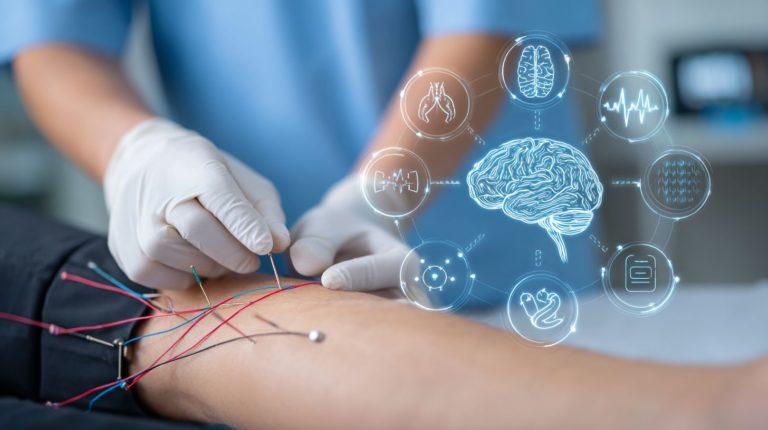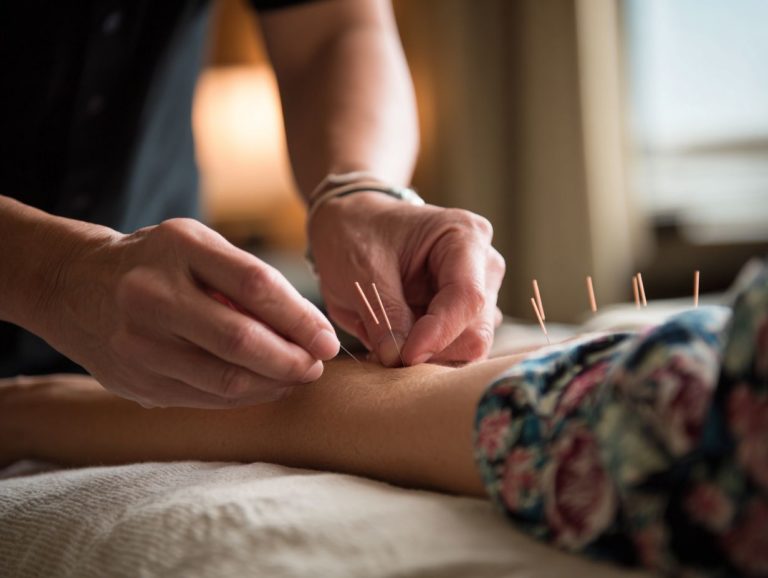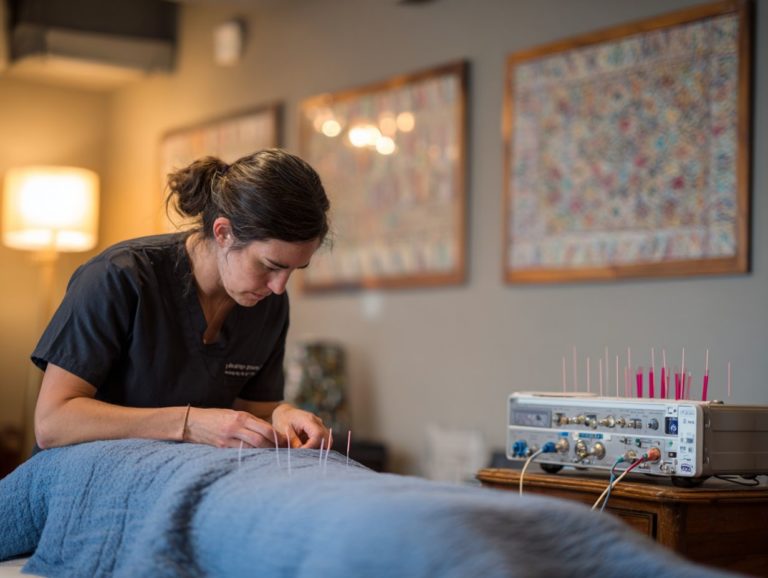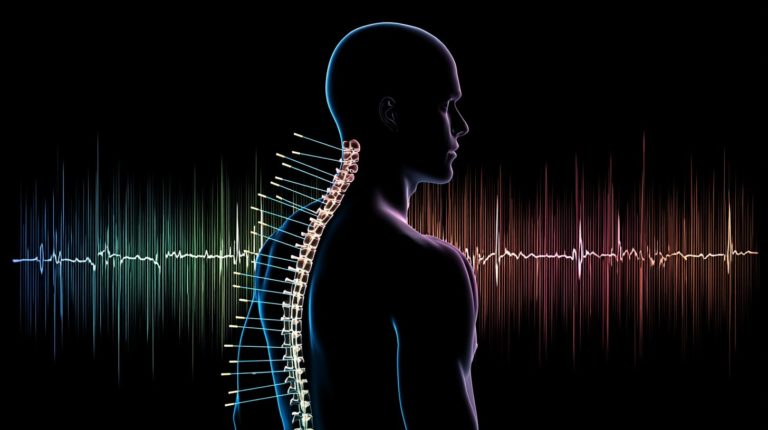Electroacupuncture: Effectiveness, Guidelines, and Safety
Electroacupuncture is a fusion of traditional acupuncture and modern technology, offering a unique approach to healing and wellness.
By incorporating electrical stimulation This technique in acupuncture increases its healing benefits.
This article looks at how electroacupuncture functions and its advantages-including pain relief, anxiety reduction, and improved sleep -along with essential guidelines for effective treatment.
Safety precautions will also be addressed, along with research supporting its effectiveness ensuring a complete grasp of this practice.
Key Takeaways:
Contents
- 1 What Is Electroacupuncture?
- 2 How Does Electroacupuncture Work?
- 3 What Are the Benefits of Electroacupuncture?
- 4 What Are the Guidelines for Electroacupuncture Treatment?
- 5 What Are the Safety Precautions for Electroacupuncture?
- 6 What Are the Side Effects of Electroacupuncture?
- 7 How Effective Is Electroacupuncture?
- 8 Electroacupuncture Clinical Data Analysis
- 8.1 Clinical Trial Results: Anxiety Score Reduction
- 8.2 Clinical Trial Results: Salivary Cortisol Levels
- 8.3 Clinical Trial Results: Gender Distribution
- 8.4 1. Studies on Pain Relief
- 8.5 2. Studies on Nausea and Vomiting Relief
- 8.6 3. Studies on Anxiety and Depression Treatment
- 8.7 4. Studies on Sleep Improvement
- 9 Frequently Asked Questions
- 9.1 What is electroacupuncture and how does it work?
- 9.2 Is electroacupuncture effective for treating certain conditions?
- 9.3 Are there any guidelines for receiving electroacupuncture treatment?
- 9.4 Is electroacupuncture safe?
- 9.5 Can anyone receive electroacupuncture treatment?
- 9.6 How often should I receive electroacupuncture treatment?
What Is Electroacupuncture?
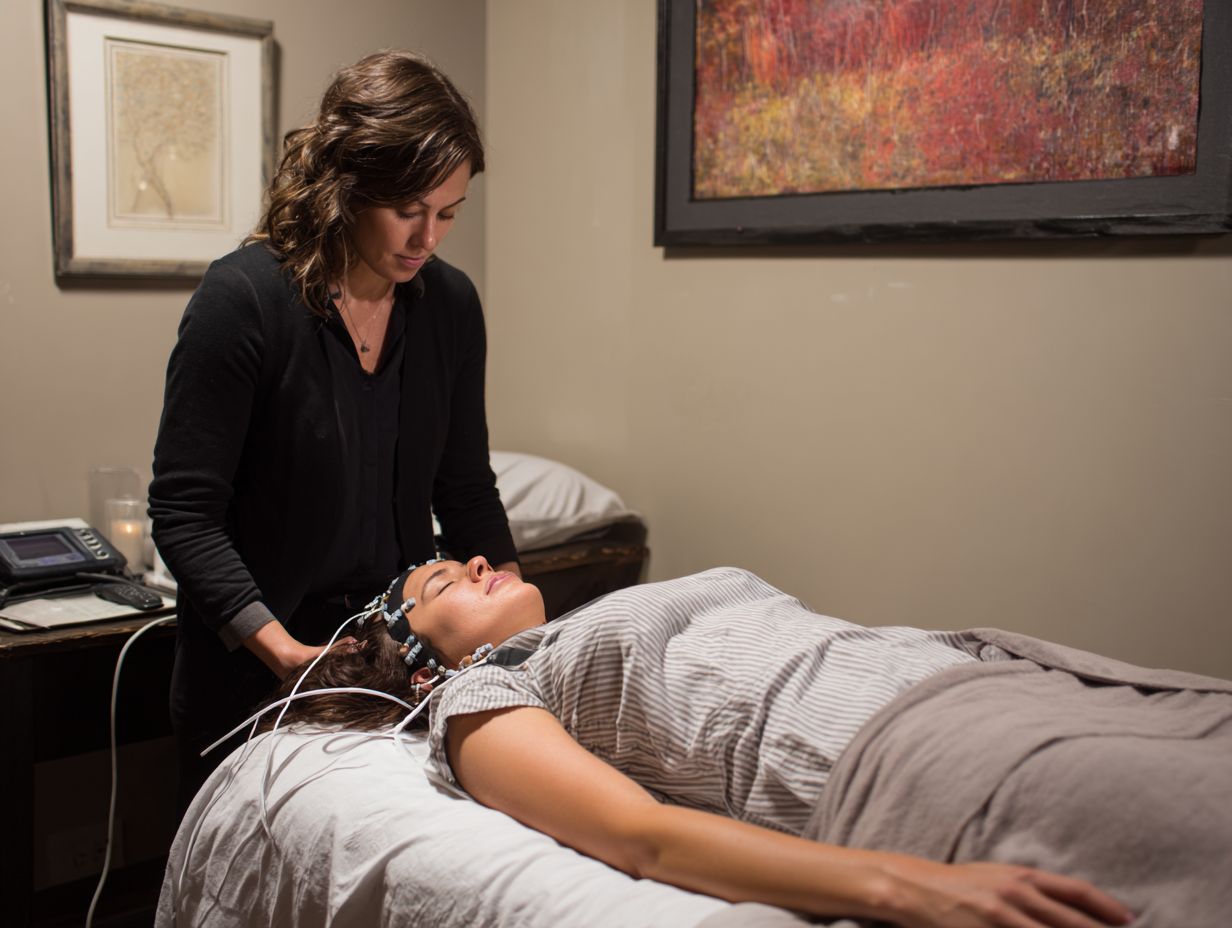
Electroacupuncture is a new therapy that mixes traditional acupuncture with electrical currents to better manage pain and treat issues like nerve-related pain and long-term pain.
This method is now widely used in hospitals like Seoul National University Hospital and Kyung Hee University Korean Medicine Hospital. It helps lessen pain and boosts health.
How Does Electroacupuncture Work?
Electroacupuncture stimulates certain acupuncture points by using needles and low-frequency electrical pulses. According to findings published by Frontiers in Neuroscience, this method helps the body relieve pain naturally and supports recovery.
It lowers pain and makes treatments work better, making it a popular choice for managing pain.
What Are the Benefits of Electroacupuncture?
Electroacupuncture provides many benefits, including pain relief, better quality of life, reduced anxiety and depression, and treatment for nausea and vomiting.
These health benefits make electroacupuncture a useful option in traditional pain management plans, especially for those looking for non-drug treatments. For more insights into its techniques and advantages, learn about acupuncture’s various benefits and approaches.
1. Pain Relief
Electroacupuncture is particularly renowned for its ability to provide effective pain relief, especially for individuals suffering from neuropathic pain and chronic pain conditions. By focusing on certain acupuncture points and using electrical stimulation, this method effectively lowers pain levels and improves the overall success of the treatment.
Research shows that electroacupuncture helps by causing the body to release endorphins and other chemicals that help control pain. A study in the journal ‘Pain’ found that patients who received electroacupuncture had a 50% reduction in pain severity compared to those who received a fake treatment.
Research using brain imaging shows that electroacupuncture affects how the brain handles pain by changing the brain areas involved in sensing pain, leading to a noticeable reduction in pain. This evidence shows it may be a useful combined method for dealing with ongoing pain, offering a practical option instead of usual drug treatments. A recent publication from ScienceDirect explores the mechanistic basis for these effects, further underscoring its potential as a viable pain management strategy.
2. Nausea and Vomiting Relief
Electroacupuncture has been shown to successfully reduce nausea and vomiting, especially for patients receiving chemotherapy. This different treatment provides a way to address these symptoms without surgery, offering helpful support along with traditional medical treatments.
Multiple clinical studies have shown that electroacupuncture is effective in various patient groups, significantly reducing nausea.
For instance, research published in the Journal of Pain and Symptom Management reported that patients receiving electroacupuncture experienced a marked decrease in chemotherapy-induced nausea compared to those receiving standard care alone.
The proposed mechanisms underlying this efficacy include the modulation of neurotransmitters such as serotonin and dopamine, which play critical roles in regulating gastrointestinal motility. Electroacupuncture can improve blood flow and increase endorphin levels, helping you feel better and reducing uncomfortable symptoms like nausea and vomiting. This aligns with findings from ClinicalTrials.gov, which confirms the benefit of acupuncture for chemotherapy-induced nausea.
3. Anxiety and Depression Treatment
Electroacupuncture offers a new way to relieve symptoms of anxiety and depression, showing it can improve life for those dealing with these mental health issues. By stimulating key acupuncture points, it can help modulate the brain’s response to stress and emotional disturbances.
This treatment is based on the principles of traditional acupuncture, but with the added benefit of electrical stimulation, which can lead to a more significant therapeutic effect.
Recent clinical trials show that people receiving electroacupuncture often experience less anxiety and more stable moods. For example, a study by researchers showed significant drops in anxiety scores among people receiving this treatment, suggesting that electroacupuncture could be important in mental health care.
By encouraging the release of endorphins and balancing neurotransmitters, it provides a complete method for managing emotions, which strengthens its increasing use in mental health care.
4. Improved Sleep
Improved sleep quality is another significant benefit associated with electroacupuncture, as the treatment can help regulate sleep patterns and reduce insomnia symptoms. By dealing with pain and anxiety, electroacupuncture can help create a sleep-friendly environment.
Studies have found that electroacupuncture greatly reduces the duration and intensity of sleep issues in patients.
Many individuals report a notable shift in their sleep patterns, often falling asleep more quickly and enjoying extended periods of uninterrupted rest. Testimonials from patients frequently mention feeling rejuvenated and more alert during the day, positively impacting their overall quality of life.
This natural approach helps with current symptoms and supports healthier sleep routines over time, offering a good option for people who want to improve their sleep without relying on medicine.
What Are the Guidelines for Electroacupuncture Treatment?
Guidelines for electroacupuncture treatment emphasize the importance of selecting a practitioner who is knowledgeable about both acupuncture and electroacupuncture techniques to provide safe and effective care.
Following clinical guidelines improves treatment effectiveness, patient contentment, and health results. For those looking to deepen their understanding of this practice, exploring the benefits and certification of electrical acupuncture can offer valuable insights.
1. Finding a Qualified Practitioner
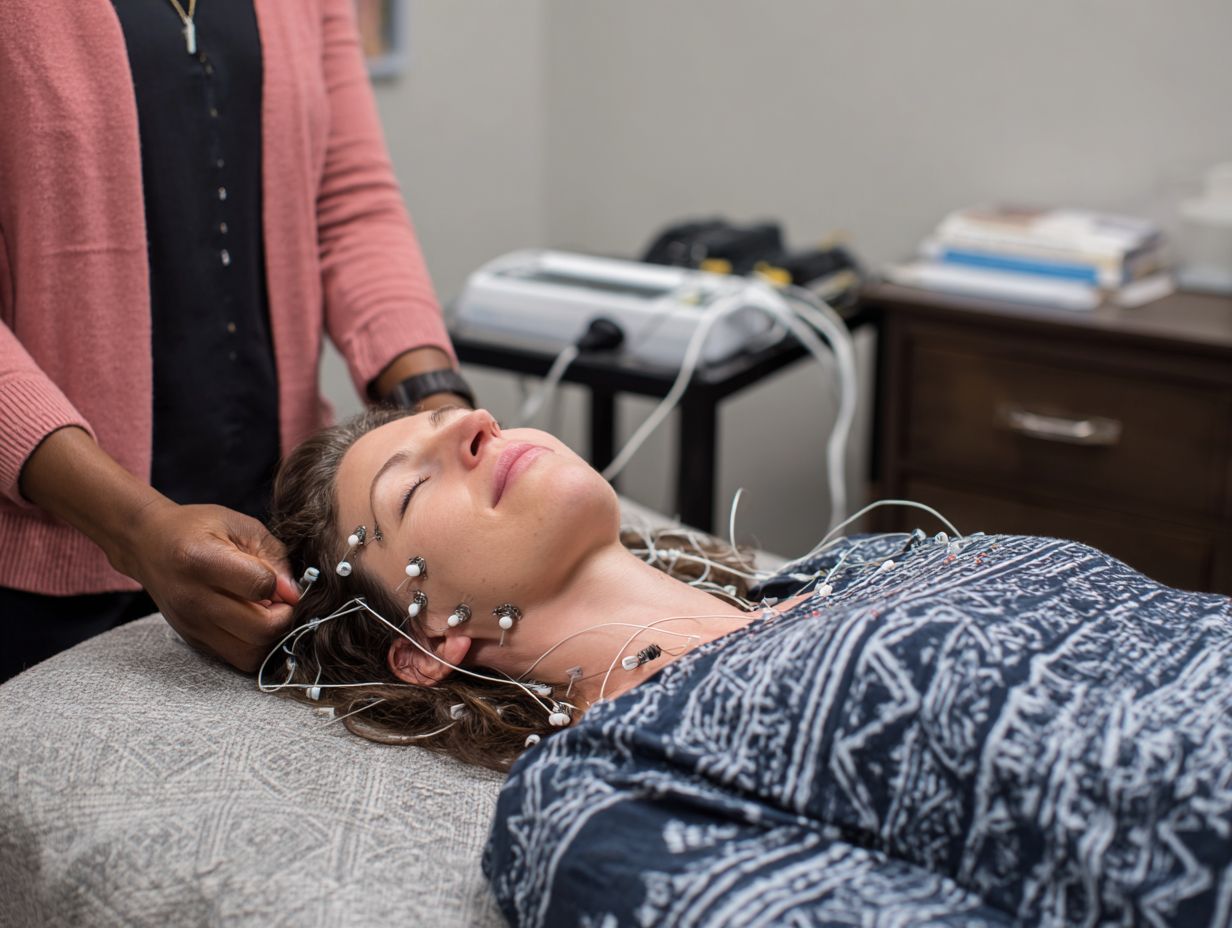
Choosing a skilled professional is important for making sure electroacupuncture works well and is safe. Practitioners must have the right training and certification in both acupuncture and electroacupuncture techniques. A knowledgeable professional can greatly improve treatment results and reduce possible dangers.
When searching for an electroacupuncturist, patients should prioritize those who have completed accredited programs at recognized training schools specifically focused on this modality.
Verifying certifications from reputable organizations can provide assurance of the practitioner’s proficiency. Membership in professional associations often indicates a commitment to ongoing education and adherence to high standards in practice, which is particularly important in a field that blends traditional methods with modern technology.
Choosing a qualified practitioner helps you trust them and makes sure the treatment works well and is safe.
2. Preparing for Treatment
Preparing properly before beginning electroacupuncture is important for effective treatment and a positive experience. Patients should be informed about what to expect during their sessions and how to communicate their specific needs and concerns with their practitioner.
The process starts with a complete evaluation before treatment. This is where people can talk about their medical background and any current health problems. This dialogue allows the practitioner to tailor the treatment effectively.
Drinking enough water and not eating big meals before sessions can improve results. Encouraging open communication and feedback during the process helps patients and improves the treatment approach.
Putting patient satisfaction first leads to better therapy experiences, building trust and cooperation between patient and doctor.
3. During Treatment
During an electroacupuncture session, patients can expect a comfortable and therapeutic environment where their individual needs and concerns are prioritized. The practitioner will carefully insert acupuncture needles and apply electrical stimulation to specific acupuncture points, tailoring the treatment to the patient’s unique requirements.
As the session progresses, individuals may feel a mild tingling or warmth around the needle sites, sensations often described as relaxing rather than uncomfortable. These sensations can signify that the treatment is effectively stimulating the flow of energy within the body.
It’s important for patients to talk openly with their doctor during treatment, mentioning any feelings or pain they experience. This communication allows for real-time changes, improving the treatment and providing a customized and helpful experience.
4. After Treatment
After electroacupuncture treatment, patients may experience varying effects, including immediate pain relief or gradual improvements in their overall quality of life. Practitioners will often give advice on how to take care of yourself and make lifestyle changes to get the most out of the therapy.
Plus these initial responses, it’s common for individuals to feel some mild side effects such as slight soreness or lightheadedness, which typically resolve quickly.
Engaging in self-care strategies, such as gentle stretching, drinking plenty of water, and allowing sufficient rest, can significantly aid recovery and extend the positive effects of the treatment.
Schedule follow-up visits quickly to assess progress and modify the treatment plan if necessary. Regular communication with the practitioner is key; it makes sure that any worries or questions are dealt with, improving the patient’s experience and increasing satisfaction with the therapy.
What Are the Safety Precautions for Electroacupuncture?
Safety measures for electroacupuncture are important to minimize risks like infections, nerve damage, and other problems.
By following clinical guidelines and using proper techniques, patients can safely benefit from this alternative therapy. For those interested in a deeper understanding, our overview of electrical acupuncture benefits and certification provides additional insights into this practice.
1. Risks of Infection
One of the primary risks associated with electroacupuncture is the potential for infection if proper hygiene practices are not followed during treatment. Ensuring needles are sterile and the treatment area is clean helps lower the risk.
Actually, professionals need to use a full range of clean methods to make sure their patients are safe. This involves diligent handwashing, using disposable gloves, and regularly disinfecting surfaces to avoid contamination.
Patients should talk to their doctor about any cleanliness concerns they have. Knowing about the treatment helps them feel more confident and encourages open talks about cleanliness, resulting in safer and more effective therapy sessions.
2. Risks of Nerve Damage
Another critical safety consideration is the risk of nerve damage, which can occur if electroacupuncture is performed by an inadequately trained practitioner or if improper techniques are used. Patients should only get treatment from qualified professionals to reduce this risk.
Ensuring patient safety during electroacupuncture involves a few strategic measures. Patients should always verify the practitioner’s credentials and experience, as this can significantly reduce the likelihood of complications.
It’s also advisable for individuals to have thorough discussions with the provider about their health history and any concerns prior to treatment. Watching closely during the procedure is very important; trained practitioners will constantly look for any signs of trouble or unusual feelings.
By following these steps, patients can greatly lower the chances of nerve damage and set up a safer and more effective treatment environment.
3. Risks for Pregnant Women
Electroacupuncture can be risky for pregnant women, so it is important to be careful with this treatment during pregnancy. It is important for healthcare providers to evaluate each person’s health and customize treatments to protect both the mother and the fetus.
Before starting any electroacupuncture sessions, practitioners should talk to the patient’s doctor to make sure there are no hidden issues that could increase any possible risks.
This teamwork helps fully grasp the woman’s health condition and any factors that might impact her treatment.
The importance of designing customized treatment plans cannot be overstated; each pregnancy is unique, and factors such as gestational age, pre-existing conditions, and any concurrent therapies must be carefully considered.
By prioritizing these precautions, practitioners can help create a safe and supportive environment for both the mother and her baby.
4. Risks for People with Pacemakers
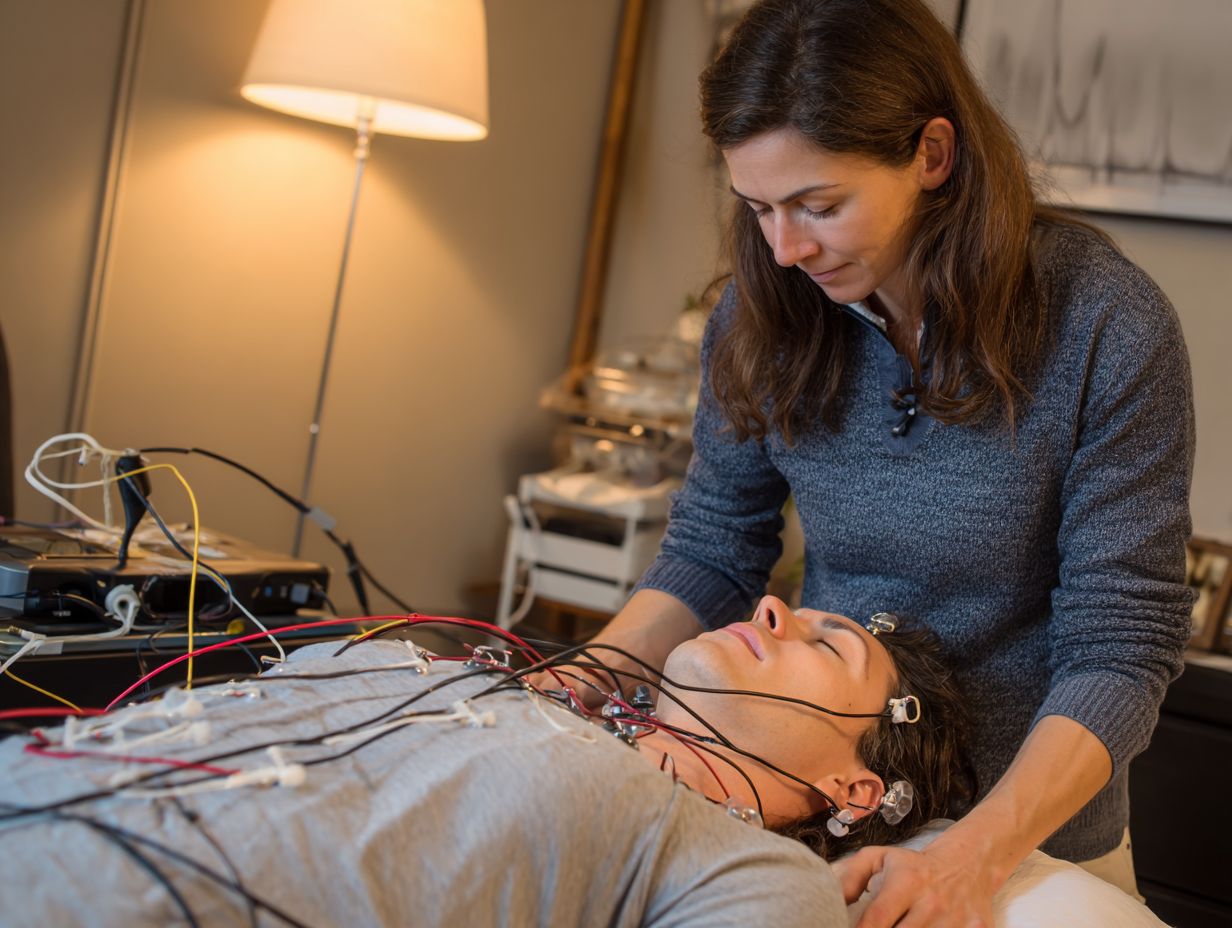
Individuals with pacemakers must exercise caution when considering electroacupuncture, as the electrical stimulation involved in the treatment can interfere with the device’s functioning. Consultation with healthcare professionals is essential to determine the safety and appropriateness of this therapy for such patients.
These patients need detailed health check-ups that take into account their heart history and the kind of pacemaker they have.
The interplay between acupuncture’s electrical currents and the pacemaker’s operation poses a genuine risk, potentially leading to complications.
Clear communication between a patient and their doctor is important to discuss health concerns so the doctor can give personalized advice.
Patients should not hesitate to discuss their concerns, as this proactive approach can significantly mitigate risks and help establish a safe treatment plan.
What Are the Side Effects of Electroacupuncture?
Though electroacupuncture is often seen as safe, some individuals might have side effects ranging from minor discomfort to serious reactions, though these are uncommon.
Assessing safety thoroughly and discussing openly with healthcare providers can reduce these risks and improve how patients feel about their treatment.
How Effective Is Electroacupuncture?
The effectiveness of electroacupuncture has been examined in many studies, including trials where participants were randomly assigned to different groups, which provide strong evidence that supports its use in managing pain and treating various conditions.
Researchers evaluate the treatment’s effect on people’s quality of life and health outcomes by carefully designing study protocols and methods for assessing pain. For a detailed understanding of how electrical acupuncture benefits these health assessments, see our electrical acupuncture guide.
Electroacupuncture Clinical Data Analysis
Electroacupuncture Clinical Data Analysis
Clinical Trial Results: Anxiety Score Reduction
Clinical Trial Results: Salivary Cortisol Levels
Clinical Trial Results: Gender Distribution
The Electroacupuncture Clinical Data Analysis Provides detailed findings from clinical trials, concentrating on reducing anxiety, hormonal shifts, and characteristics of participants. This analysis sheds light on the potential therapeutic benefits of electroacupuncture and traditional acupuncture.
Clinical Trial Results detail the efficacy of electroacupuncture in reducing anxiety scores. The p-values indicate statistical significance, with 5 sessions showing a p-value of 0.05, suggesting a borderline significant reduction in anxiety. In contrast, 10 sessions achieved a p-value of 0.001, indicating a highly significant anxiety reduction, demonstrating increased effectiveness with more sessions.
Regarding Salivary Cortisol Levels, the study compares the effects of acupuncture and electroacupuncture on morning cortisol, a stress hormone. Traditional acupuncture led to a 43.1% reduction, whereas electroacupuncture resulted in a 38.2% reduction. Although both methods effectively lower cortisol levels, traditional acupuncture showed a slightly greater reduction, suggesting variances in how each method influences physiological stress markers.
- Gender Distribution: The participant breakdown reveals 14.29% male and 85.71% female, highlighting a predominance of female participants in this study. This skewed distribution may influence the generalizability of the results and suggests the need for further research with a more balanced gender representation to fully understand gender-specific responses to electroacupuncture.
In summary, the data from the Electroacupuncture Clinical Data Analysis highlights how electroacupuncture can help manage anxiety and reduce stress, while showing the small differences in effectiveness between electroacupuncture and traditional acupuncture. The imbalance between male and female participants needs attention when examining the results. Later research should strive for a more balanced gender ratio to ensure the results apply to various groups.
1. Studies on Pain Relief
Many studies have looked into how well electroacupuncture works for pain relief. They show that it can significantly help people with neuropathic pain and long-term pain. These randomized clinical trials provide important evidence about electroacupuncture’s role in managing pain.
Each study used strong methods, often comparing electroacupuncture with traditional acupuncture or fake treatments. Results revealed that many participants experienced notable reductions in pain intensity and improved functionality, with some trials reporting sustained benefits even after treatment cessation.
This clinical evidence highlights the importance of including electroacupuncture in pain management plans, especially as practitioners look to use methods backed by research.
It suggests new research topics, encouraging more studies on how effective electroacupuncture is for various individuals and kinds of pain, aiming to improve pain treatments.
2. Studies on Nausea and Vomiting Relief
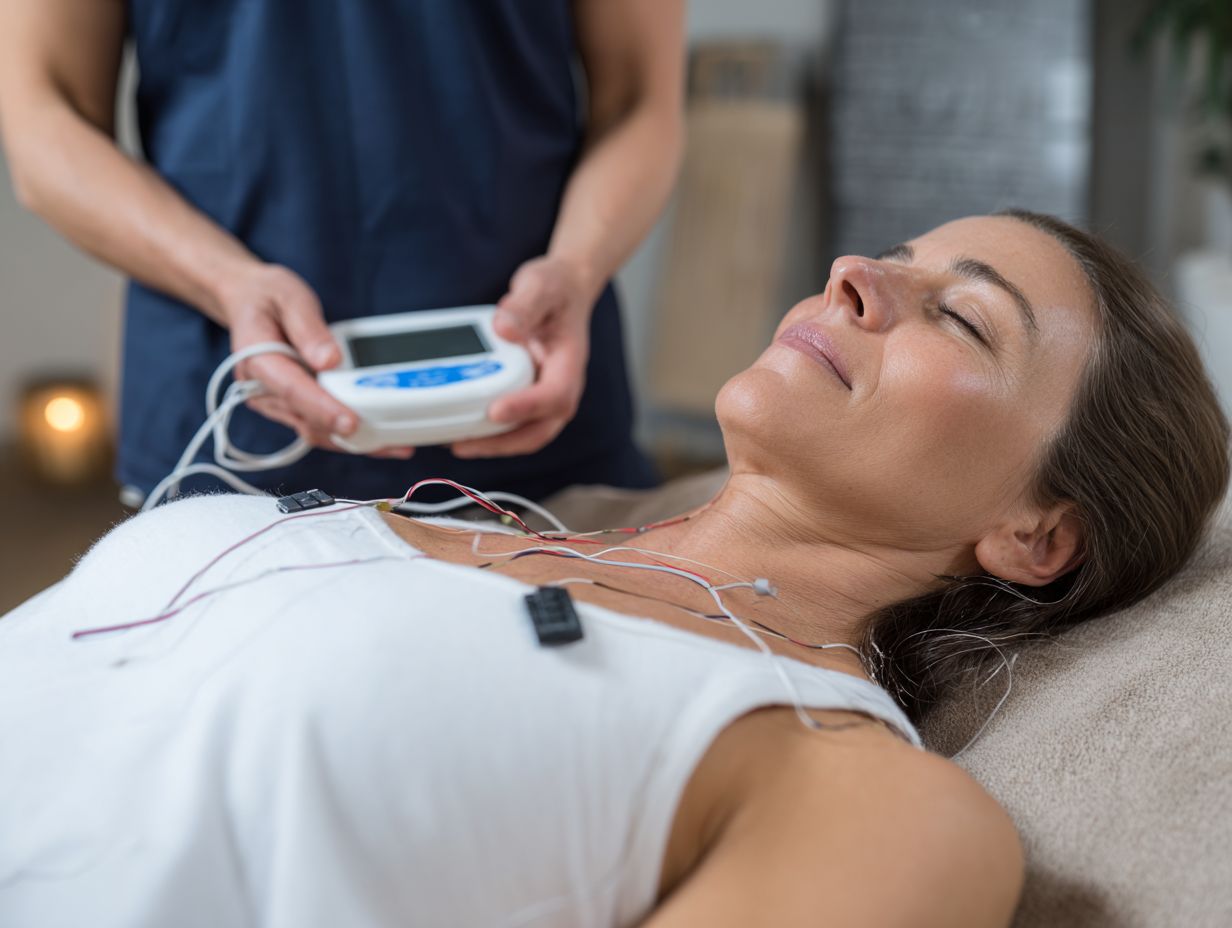
Clinical research has shown that electroacupuncture can be highly effective in reducing nausea and vomiting, particularly in patients undergoing chemotherapy and other treatments. Many clinical trials have shown that it works well for treatment and supports its use in care.
These studies typically employ randomized controlled trial designs, where participants receive either electroacupuncture or a placebo treatment to evaluate true effectiveness.
Findings indicate that patients experience significant reductions in both the frequency and intensity of nausea and vomiting after undergoing electroacupuncture sessions.
The impact on patient care is significant; by including this method in treatment plans, healthcare providers can improve the quality of life for people dealing with the difficult side effects of cancer treatments.
Knowing how electroacupuncture works could lead to more specific and useful treatments for managing nausea.
3. Studies on Anxiety and Depression Treatment
Research into the use of electroacupuncture for anxiety and depression treatment has yielded promising results, indicating significant improvements in symptoms and overall well-being among treated individuals. Clinical evidence supports its efficacy as a complementary approach in mental health management.
Many studies have used randomized controlled trials and long-term research to examine how electroacupuncture affects different anxiety and depressive disorders.
These studies often show significant decreases in symptoms and improvements in patients’ well-being and ability to handle emotions. Patient satisfaction surveys consistently show that patients have a positive view and appreciation for their treatment experiences, indicating an increasing desire to include these approaches in complete treatment plans.
Using electroacupuncture with regular treatments, mental health professionals can provide better care that looks after both the physical and mental health of patients.
4. Studies on Sleep Improvement
Recent studies have indicated that electroacupuncture can significantly improve sleep quality, offering a beneficial alternative for individuals struggling with insomnia and sleep disturbances. These findings increase our knowledge of how electroacupuncture improves overall quality of life.
Researchers have employed various methodologies to assess the efficacy of this treatment, including randomized controlled trials and patient surveys.
Participants often report noticeable improvements in sleep onset, duration, and overall restorative sleep quality. Feedback indicates that, unlike usual drug treatments, electroacupuncture offers a complete method without the harmful side effects often linked to medication.
These studies highlight the importance of looking into non-drug options, especially for those who want to improve their health with natural treatments. This is particularly important in a world increasingly focused on integrative health solutions.
Frequently Asked Questions
What is electroacupuncture and how does it work?
Electroacupuncture is a form of acupuncture that involves using small electrical currents to stimulate specific points on the body. These points are believed to correspond with different organs and systems in the body, and the electrical stimulation is thought to promote the flow of energy and relieve pain or other symptoms.
Is electroacupuncture effective for treating certain conditions?
There is some evidence to suggest that electroacupuncture can be effective for certain conditions, such as chronic pain, nausea, and neurological disorders. However, more research is needed to fully know how well it works and to find out which conditions it helps the most.
Are there any guidelines for receiving electroacupuncture treatment?
Yes, it is important to receive electroacupuncture treatment from a trained and licensed acupuncturist. They will be able to properly assess your condition and determine the appropriate points to stimulate. It is also important to follow their recommendations for frequency and duration of treatment.
Is electroacupuncture safe?
Electroacupuncture is generally considered to be safe when performed by a trained and licensed practitioner. However, there are some possible risks, like getting an infection or nerve injury, so it’s important to follow hygiene and safety rules during treatment.
Can anyone receive electroacupuncture treatment?
Electroacupuncture might not be safe for all individuals, particularly those with specific health issues or during pregnancy. It is important to discuss your medical history with your practitioner before beginning treatment to determine if electroacupuncture is a safe option for you.
How often should I receive electroacupuncture treatment?
The frequency of electroacupuncture treatments will depend on your specific condition and how your body responds to treatment. It is best to follow the recommendations of your acupuncturist, who will monitor your progress and adjust the frequency as needed.

Sheetal Sharda has a background in CS. She got an interest in Holistic living back in 2018, and has since started exploring more into Naturapathy, Holistic Living, Yoga, and more. She got inspired to start SereneClinics to help people find reliable centers across the world.


